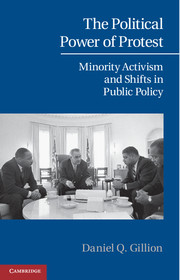Book contents
- Frontmatter
- Contents
- List of Figures
- List of Tables
- Preface
- Acknowledgments
- Introduction
- 1 A Continuum of Information
- 2 Measuring Information in Minority Protest
- 3 Viewing Minority Protest from the Hill
- 4 Knocking on the President’s Door
- 5 Appealing to an Unlikely Branch
- Conclusion
- Appendix A Defining Minority Political Protest
- Appendix B Study Description and Coding Across Multiple Institutions
- Appendix C Time Series Methods
- References
- Index
4 - Knocking on the President’s Door
The Impact of Minority Protest on Presidential Responsiveness
Published online by Cambridge University Press: 05 February 2013
- Frontmatter
- Contents
- List of Figures
- List of Tables
- Preface
- Acknowledgments
- Introduction
- 1 A Continuum of Information
- 2 Measuring Information in Minority Protest
- 3 Viewing Minority Protest from the Hill
- 4 Knocking on the President’s Door
- 5 Appealing to an Unlikely Branch
- Conclusion
- Appendix A Defining Minority Political Protest
- Appendix B Study Description and Coding Across Multiple Institutions
- Appendix C Time Series Methods
- References
- Index
Summary
No effort to list the president’s opportunities to use the prestige of his office to further civil rights could be adequate; from fireside chats to appearances at major events, the list is endless. All that is needed at the outset is a firm resolve to make the presidency a weapon for this democratic objective; the opportunities would then arise by themselves.
– Dr. Martin Luther King Jr.Since the early twentieth century, racial and ethnic minorities have descended upon the South Lawn gates of the White House and at Lafayette Park in massive numbers, hoping to garner the president’s attention. Such appeals have not been restricted to Washington; protesters throughout the nation have made appeals directly to the president. This chapter attempts to assess whether the information in these protest actions was able to resonate in the Oval Office and elicit a presidential response.
We saw in Chapter 3 that congressional representatives often look to informative protest actions within their own districts to understand and address citizens’ concerns. When we shift our focus to the presidential branch of government, the scale of representation expands to include the entire nation, but the pursuit to understand the most pressing issues of citizens remains. As we shall see, the social context of minority protest has provided presidents with an understanding of racial and ethnic minority concerns.
- Type
- Chapter
- Information
- The Political Power of ProtestMinority Activism and Shifts in Public Policy, pp. 84 - 116Publisher: Cambridge University PressPrint publication year: 2013



